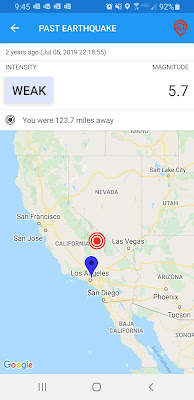Update on QuakeAlert
In my post Earthquake Early Warning one of the earthquake early warning systems mentioned was QuakeAlert.
Developed by Early Warning Labs, who partnered with USGS, QuakeAlert's objective is to quickly detect the initial energy waves produced by an earthquake. These first energy waves, called P-waves, rapidly radiate from the epicenter.
Using P-waves the location, magnitude, and anticipated ground shaking (this correlates to possible damage is basically what the Mercalli Intensity Scale attempts to quantify) can be estimated. Based on these estimations warnings are distributed to state emergency response, critical infrastructure, businesses, and the public before the damaging S-waves hit.
The S-waves are when the real shaking and damage occur. Depending on the earthquake's magnitude, depth, and other factors, such as ground composition and your distance from the epicenter, your warning may give you up to 60 seconds before the earthquake strikes. The expectation is to provide at least 20 seconds of warning.
That doesn't seem like much time. And it could be less. But it can be enough for critical actions that can protect life and property. These actions include:
- Taking protective action like Drop, Cover, and Hold On.
- Make general or mass announcements/notifications.
- Fire departments can open their bay doors (so the quake doesn't damage the doors making it difficult or impossible for the emergency vehicles to leave) and notify their responders.
- Airports can notify pilots on the ground to slow and stop their aircraft.
- If measures are in place, vehicles can be limited from going on to bridges/overpasses or entering tunnels.
- Those working in hazardous environments or with dangerous machinery can be warned to get to a safe location.
- Critical infrastructure--such as gas lines, water treatment plants, or nuclear reactors--can be shut down or placed into a safe mode.
- Other industrial systems can be set up to automatically shut down upon receive warning.
In case your wondering, these early warning systems aren't new. In fact, the United States is behind the curve in implementing these system. Japan, Mexico, Taiwan and other nations have systems of differing complexity and coverage.
QuakeAlert's eventual coverage is expected to be California, Oregon, and Washington.
Right now the system is delivering alerts to California and Oregon.
You can find out more information on the QuakeAlert mobile apps on this page. It is a free app.
I'm in Utah so it won't give me any warnings for Utah quakes, but I downloaded the app a couple years ago out of curiosity. It has a simulation, so you get an idea of what the app would be like in a real earthquake. And there's some earthquake information.
In the event of a big Utah earthquake I expect the QuakeAlert will probably send out a warning because (depending on the size of the quake) the shaking may be felt in parts of California. But it may not give me much, if any warning, because the S-waves might already be shaking things in Utah when the P-waves are detected by the sensors in California.
The email I received from Early Warning Labs also linked to a PDF brochure about QuakeAlert
And, in case you're wondering, I receive no incentives, financial or otherwise, from Early Warning Labs. I'm looking to share information and help people become more aware of earthquake hazards and to be better prepared for them.



Comments
Post a Comment